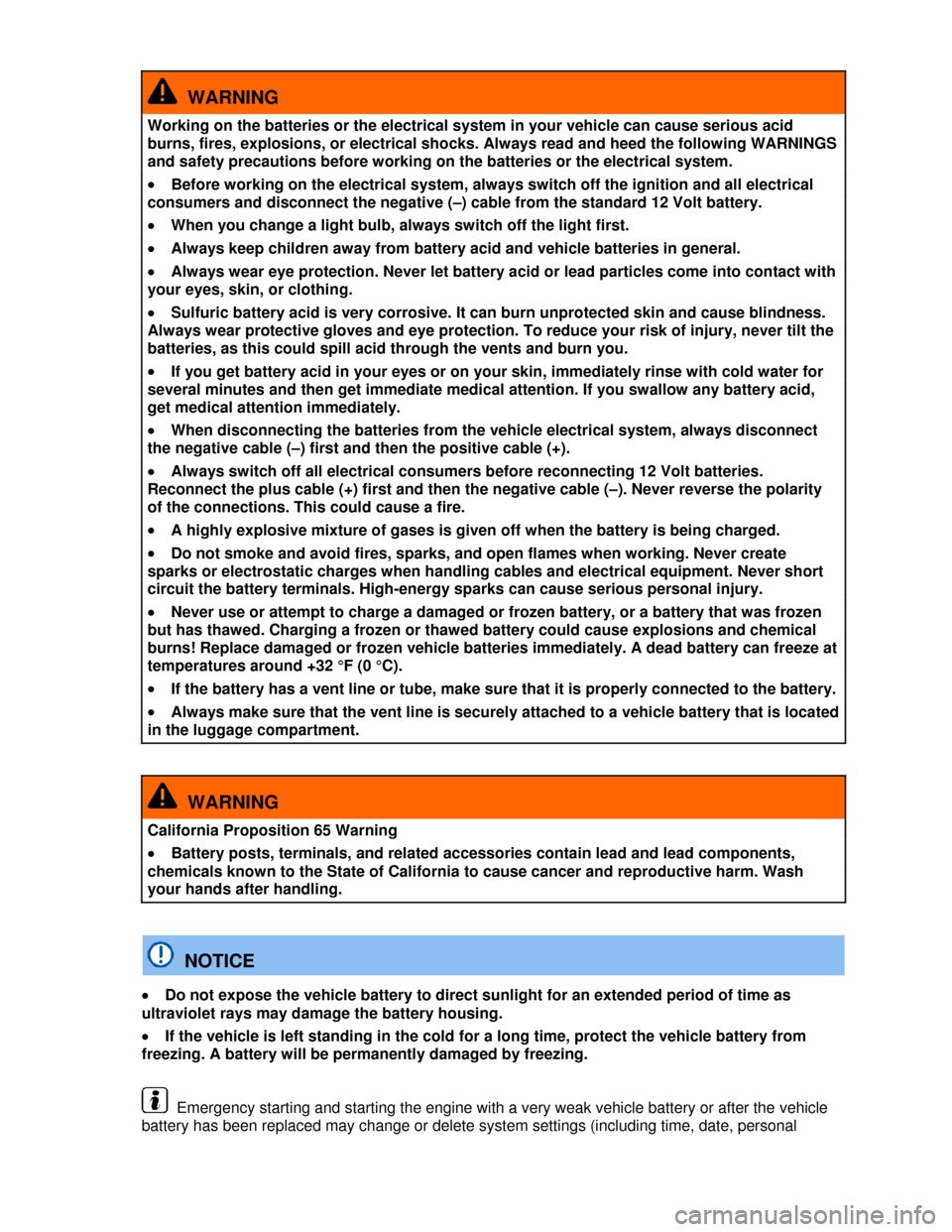2013 VOLKSWAGEN TIGUAN Ignition
[x] Cancel search: IgnitionPage 218 of 356

1) Do not use Rear Assist in the following situations:
– If the position or angle of the camera was changed, such as after a rear-end collision, have the
system checked by an authorized Volkswagen dealer or an authorized Volkswagen Service Facility.
2.) Examples of optical deception by the camera: (examples)
– The Rear Assist camera provides only two-dimensional images. Recesses and protruding objects
on the ground or protruding parts on other vehicles are difficult or impossible to identify due to the
lack of depth of field.
– Objects or another vehicle may seem closer or farther away on the screen than they really are.
– When driving from a level surface onto an upward or downward slope.
– When driving up or down a slope onto a level surface.
– If the rear of the vehicle is heavily loaded.
– When approaching protruding objects. These objects can disappear from the field of view when
backing up.
Cleaning the camera lens
Keep camera lens clean and free of snow and ice.
�x Engage the parking brake.
�x Switch on the ignition.
�x Select the reverse gear.
�x Wet the camera lens with a commercially available alcohol-based glass cleaner and clean with a
dry cloth ⇒ .
�x Remove snow with a brush.
�x Remove ice with deicer spray ⇒ .
NOTICE
�x Never use abrasive cleaning agents to clean the camera lens.
�x Never remove snow or ice on the camera lens with warm or hot water. This can damage the
camera lens.
Volkswagen recommends practicing parking with Rear Assist in a safe place with little or no
traffic or in a parking lot under good visibility and weather conditions in order to familiarize yourself
with the system, the orientation lines and the way they work.
Rear Assist cannot be activated when the factory-installed trailer hitch is electrically connected to
the trailer or the rear hatch is open.
Page 223 of 356

Display
Different cruise control versions are available. The stored speed is shown in the instrument cluster
display on some equipment versions.
Status ⇒ fig.
(A) Cruise control temporarily deactivated. Stored speed in small numbers.
(B) System malfunction. See an authorized Volkswagen dealer or an authorized Volkswagen
Service Facility.
(C) Cruise control activated. No speed stored in memory.
(D) Cruise control is active. Stored speed in large numbers.
Lights up Possible cause
�% Cruise control is regulating the vehicle speed.
�#�2�5�)�3�%
When the ignition is switched on, several warning and indicator lights come on briefly for a function
check. They go out after a few seconds.
WARNING
Failure to heed warning lights and instrument cluster text messages can cause the vehicle to
break down in traffic and result in a collision and serious personal injury.
�x Never ignore warning lights or text WARNINGS.
�x Always stop the vehicle as soon as it is safe to do so.
NOTICE
Failure to heed warning lights or text WARNINGS can result in vehicle damage.
Cruise control operation
Fig. On the left side of the steering column: Cruise control buttons and switches.
�
Page 229 of 356

NOTICE
Failure to heed warning lights or text WARNINGS can result in vehicle damage.
If the ignition is switched on, an acoustic warning sounds when low tire pressure is detected. If a
system malfunction is detected, no acoustic warning sounds.
Driving for a longer period of time on rough roads or with a dynamic and sporty style can make
the TPMS system temporarily unavailable. The indicator light will come on, signaling a malfunction, but
will go out again once road condition or driving style change.
Tire Pressure Monitoring System and recalibration with the MFI
�
Page 230 of 356

Your vehicle has also been equipped with a TPMS malfunction indicator to indicate when the system
is not operating properly. The TPMS malfunction indicator is combined with the low tire pressure
telltale. When the system detects a malfunction, the telltale will flash for approximately one minute and
then remain continuously illuminated. This sequence will continue upon subsequent vehicle start-ups
as long as the malfunction exists.
When the malfunction indicator is illuminated, the system may not be able to detect or signal low tire
pressure as intended. TPMS malfunctions may occur for a variety of reasons, including the installation
of replacement or alternate tires or wheels on the vehicle that prevent the TPMS from functioning
properly. Always check the TPMS malfunction telltale after replacing one or more tires or wheels on
your vehicle to ensure that the replacement or alternate tires and wheels allow the TPMS to continue
to function properly.
Resetting and recalibrating the benchmark tire pressure
Resetting the tire pressures in the Multi-function Indicator (MFI) resets the benchmark tire pressure
used by the TPMS to the current tire pressure in the tires based on the circumference of the tires.
To reset the reference tire pressure, switch on the ignition. In the MFI, navigate to the Settings menu
and select Tire pressure. Store and confirm the new tire pressures.
The re-calibration must be performed each time the tire pressure in one or more tires has been
adjusted or after one or more tires has been changed, exchanged, or repaired. The new tire pressures
are stored in the system only after at least 20 minutes of normal driving.
If you have reset the benchmark tire pressure when your tires do not have the correct tire pressure,
this will prevent the TPMS from working properly. It may then give false warnings or may not give any
warning even if the tire pressure is too low.
For this reason, it is vital to make certain that all four tires are inflated to the correct pressure
when they are cold, before calibrating the system. Cold tire tires are tires that have not been driven
more than a couple of miles (kilometers) at low speed within the last 3 hours.
Recalibrate the system to reset the benchmark TPMS pressure in the following
situations:
�x After installing tires on your vehicle that have recommended cold tire inflation pressures that are
different from the tires that were taken off.
�x After any tire on your vehicle is removed and then remounted, even if the same tire and wheel rim
that were taken off are reinstalled (for instance, after repair).
�x After any tire on your vehicle is changed and replaced by another tire, even if the replacement tire
is the same type and is inflated to the same pressure as the tire it replaced.
�x After adjusting the tire pressure of any tire on the vehicle to its correct cold tire inflation pressure,
either by putting air in one or more tires or by letting air out. Do this even though air was only added
(or let out) to bring the tire to the inflation pressure it should have had all along.
�x After rotating the front and rear wheels
�x After mounting the compact spare tire.
WARNING
Incorrect calibration can cause the TPMS to give false warnings or to give no warning despite
dangerously low tire pressures. Make certain the tire inflation pressure of all tires is correct
before calibrating the system.
Page 268 of 356

WARNING
The engine compartment of any motor vehicle is a potentially dangerous area and can cause
serious personal injury.
�x Always use extreme caution when doing any work in the engine compartment. Always
follow commonly accepted safety practices and use common sense. Never risk personal
injury.
�x Never perform any work in the engine compartment unless you know exactly how to carry
out the job and have the correct technical information and the correct tools.
�x If you are uncertain about what to do, have the work performed by an authorized
Volkswagen dealer, an authorized Volkswagen Service Facility, or another qualified
workshop. Serious personal injury may result from improperly performed work.
�x We strongly recommend that you always have HID - High Intensity Discharge (Xenon)
lights and H7/H15 bulbs replaced by a qualified technician. Serious personal injury may result
from improperly performed work.
�x Never open or close the engine hood if steam or coolant is escaping. Hot steam or coolant
can cause serious burns. Always wait until you no longer see or hear steam or coolant
escaping from the engine.
�x Always let the engine cool down completely before carefully opening the hood.
�x Hot parts of the engine and the exhaust system will burn skin on contact.
�x When the engine has cooled down and you are ready to open the hood:
– Firmly apply the parking brake and shift the transmission into Park (P) (automatic) or
Neutral (manual only).
– Take the vehicle key out of the ignition.
– On vehicles with Keyless Access, make sure that the remote control vehicle key is out
of range of the vehicle and that the vehicle cannot be started by depressing the starter
button.
– Always keep children and others away from the engine compartment and never leave
them unsupervised.
�x The engine coolant system is under pressure when the engine is hot. Never unscrew the
coolant expansion tank cap when the engine is hot. Hot coolant can spray out and cause
severe burns and other serious injuries.
– Turn the cap slowly and very carefully in a counterclockwise direction while applying
light downward pressure on the top of the cap.
– Always protect your face, hands, and arms from hot escaping coolant or steam by
covering the cap with a large, thick rag.
�x Never spill fluids on the engine or exhaust system when refilling. Spilling fluids onto hot
parts of the engine or exhaust system can cause a fire.
WARNING
High voltage systems in the engine compartment can cause electrical shocks or even
electrocution, severe burns, other serious injuries, and even death!
�x Never short-circuit the electrical system. Be especially careful when using jumper cables.
The vehicle's battery could explode!
�x To reduce the risk of electrical shock and personal injury while the engine is running or
being started:
– Never touch ignition cables. Never touch other components of the high voltage
electronic ignition system.
– Never touch the wiring of the HID - High Intensity Discharge (Xenon) headlights.
Page 269 of 356

WARNING
Moving parts in the engine compartment can cause serious personal injury on contact.
�x Never reach into the area around or touch the radiator fan. Contact with the blades can
cause serious personal injury. Always remember that the radiator fan is temperature-
controlled and can come on suddenly even when the engine has been switched off for a while
and the key has been removed from the ignition.
�x If you have to perform a check or repair when the engine is running, there are more risks
from the rotating parts, such as the drive belts, alternator, radiator fan, etc., and from the
high-voltage ignition system. Always use extreme care.
– Always make sure that jewelry, loose clothing and long hair do not get caught in
rotating engine parts. Before starting any work remove your jewelry, take off your necktie,
tie back and cover your hair, and do not wear clothing that can hang down and get caught
in moving engine parts.
– Always use extreme caution if the accelerator pedal has to be depressed to perform a
check. The vehicle will start to move even if the electronic parking brake is on.
�x Never leave any objects in the engine compartment, for example cleaning rags and tools.
Objects left behind can cause malfunctions, engine damage, and even fires.
WARNING
Operating fluids and some materials in the engine compartment can catch fire easily, causing
burns and other serious personal injuries!
�x Do not smoke.
�x Never work next to open flames or sparks.
�x Never pour or spill operating fluids or other flammable liquids on the engine. These fluids
can ignite on hot engine parts and cause injuries.
�x If work on the fuel system or the electrical system is necessary:
– Always disconnect the 12 Volt vehicle battery. Make sure the vehicle is unlocked when
you disconnect the battery, or the alarm will go off. Never touch the electrical wiring of the
ignition system.
– Never work near heaters, water heaters, or other open flames.
�x Always have a functional, approved fire extinguisher nearby.
NOTICE
When changing or topping off fluids, make sure that you pour the fluids into the correct
reservoirs. Adding the wrong type of operating fluids will cause serious malfunctions and
engine damage.
Fluid leaks are harmful to the environment. Regularly check the ground underneath your vehicle
for this reason. If you find spots of oil or other fluids, have your vehicle checked by your authorized
Volkswagen dealer or authorized Volkswagen Service Facility. Dispose of leaked operating fluids
properly.
Warning light
�
Page 281 of 356

WARNING
Working on the batteries or the electrical system in your vehicle can cause serious acid
burns, fires, explosions, or electrical shocks. Always read and heed the following WARNINGS
and safety precautions before working on the batteries or the electrical system.
�x Before working on the electrical system, always switch off the ignition and all electrical
consumers and disconnect the negative (–) cable from the standard 12 Volt battery.
�x When you change a light bulb, always switch off the light first.
�x Always keep children away from battery acid and vehicle batteries in general.
�x Always wear eye protection. Never let battery acid or lead particles come into contact with
your eyes, skin, or clothing.
�x Sulfuric battery acid is very corrosive. It can burn unprotected skin and cause blindness.
Always wear protective gloves and eye protection. To reduce your risk of injury, never tilt the
batteries, as this could spill acid through the vents and burn you.
�x If you get battery acid in your eyes or on your skin, immediately rinse with cold water for
several minutes and then get immediate medical attention. If you swallow any battery acid,
get medical attention immediately.
�x When disconnecting the batteries from the vehicle electrical system, always disconnect
the negative cable (–) first and then the positive cable (+).
�x Always switch off all electrical consumers before reconnecting 12 Volt batteries.
Reconnect the plus cable (+) first and then the negative cable (–). Never reverse the polarity
of the connections. This could cause a fire.
�x A highly explosive mixture of gases is given off when the battery is being charged.
�x Do not smoke and avoid fires, sparks, and open flames when working. Never create
sparks or electrostatic charges when handling cables and electrical equipment. Never short
circuit the battery terminals. High-energy sparks can cause serious personal injury.
�x Never use or attempt to charge a damaged or frozen battery, or a battery that was frozen
but has thawed. Charging a frozen or thawed battery could cause explosions and chemical
burns! Replace damaged or frozen vehicle batteries immediately. A dead battery can freeze at
temperatures around +32 °F (0 °C).
�x If the battery has a vent line or tube, make sure that it is properly connected to the battery.
�x Always make sure that the vent line is securely attached to a vehicle battery that is located
in the luggage compartment.
WARNING
California Proposition 65 Warning
�x Battery posts, terminals, and related accessories contain lead and lead components,
chemicals known to the State of California to cause cancer and reproductive harm. Wash
your hands after handling.
NOTICE
�x Do not expose the vehicle battery to direct sunlight for an extended period of time as
ultraviolet rays may damage the battery housing.
�x If the vehicle is left standing in the cold for a long time, protect the vehicle battery from
freezing. A battery will be permanently damaged by freezing.
Emergency starting and starting the engine with a very weak vehicle battery or after the vehicle
battery has been replaced may change or delete system settings (including time, date, personal
Page 321 of 356

Lights
up Possible cause Proper response
�B
Engine control/monitoring system
malfunction (engine Malfunction Indicator
Light - MIL).
Ease off the accelerator. Carefully drive to the
nearest authorized Volkswagen dealer or
authorized Volkswagen Service Facility. Have
engine checked.
Flashes Possible cause Proper response
�B Misfire, which can damage the catalytic
converter.
Ease off the accelerator. Carefully drive to the
nearest authorized Volkswagen dealer or
authorized Volkswagen Service Facility. Have
engine checked.
When the ignition is switched on, several warning and indicator lights come on briefly for a function
check. They go out after a few seconds.
NOTICE
Failure to heed warning lights or text WARNINGS can result in vehicle damage.
As long as the indicator lights x or EPC are on, expect engine malfunctions, increased fuel
consumption and loss of engine efficiency.
Catalytic Converter
�